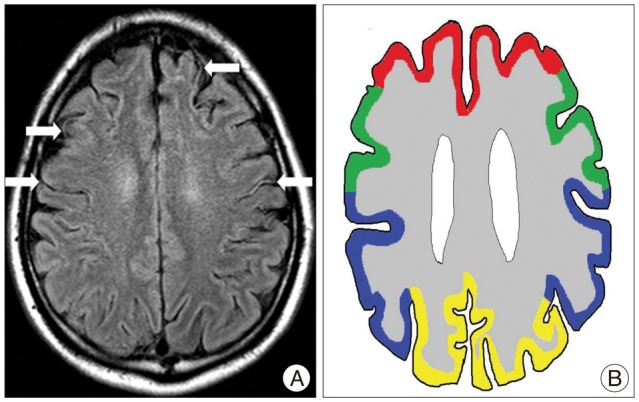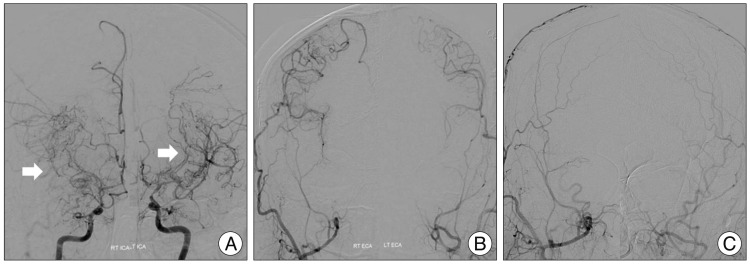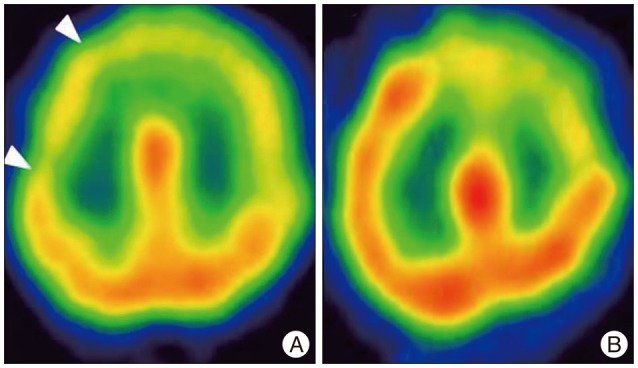J Korean Neurosurg Soc.
2013 Oct;54(4):302-308. 10.3340/jkns.2013.54.4.302.
The Usefulness of the Ivy Sign on Fluid-Attenuated Intensity Recovery Images in Improved Brain Hemodynamic Changes after Superficial Temporal Artery-Middle Cerebral Artery Anastomosis in Adult Patients with Moyamoya Disease
- Affiliations
-
- 1Department of Neurosurgery, Eulji University Hospital, College of Medicine, Eulji University, Daejeon, Korea. neurocsy@eulji.ac.kr
- KMID: 1499335
- DOI: http://doi.org/10.3340/jkns.2013.54.4.302
Abstract
OBJECTIVE
MR perfusion and single photon emission computerized tomography (SPECT) are well known imaging studies to evaluate hemodynamic change between prior to and following superficial temporal artery (STA)-middle cerebral artery (MCA) anastomosis in moyamoya disease. But their side effects and invasiveness make discomfort to patients. We evaluated the ivy sign on MR fluid attenuated inversion recovery (FLAIR) images in adult patients with moyamoya disease and compared it with result of SPECT and MR perfusion images.
METHODS
We enrolled twelve patients (thirteen cases) who were diagnosed with moyamoya disease and underwent STA-MCA anastomosis at our medical institution during a period ranging from September of 2010 to December of 2012. The presence of the ivy sign on MR FLAIR images was classified as Negative (0), Minimal (1), and Positive (2). Regions were classified into four territories: the anterior cerebral artery (ACA), the anterior MCA, the posterior MCA and the posterior cerebral artery.
RESULTS
Ivy signs on preoperative and postoperative MR FLAIR were improved (8 and 4 in the ACA regions, 13 and 4 in the anterior MCA regions and 19 and 9 in the posterior MCA regions). Like this result, the cerebrovascular reserve (CVR) on SPECT was significantly increased in the sum of CVR in same regions after STA-MCA anastomosis.
CONCLUSION
After STA-MCA anastomosis, ivy signs were decreased in the cerebral hemisphere. As compared with conventional diagnostic modalities such as SPECT and MR perfusion images, the ivy sign on MR FLAIR is considered as a useful indicator in detecting brain hemodynamic changes between preoperatively and postoperatively in adult moyamoya patients.
Keyword
MeSH Terms
Figure
Reference
-
1. Baba T, Houkin K, Kuroda S. Novel epidemiological features of moyamoya disease. J Neurol Neurosurg Psychiatry. 2008; 79:900–904. PMID: 18077479.
Article2. Cosnard G, Duprez T, Grandin C, Smith AM, Munier T, Peeters A. Fast FLAIR sequence for detecting, major vascular abnormalities during the hyperacute phase of stroke : a comparison with MR angiography. Neuroradiology. 1999; 41:342–346. PMID: 10379591.
Article3. Fujimura M, Mugikura S, Shimizu H, Tominaga T. Diagnostic value of perfusion-weighted MRI for evaluating postoperative alteration of cerebral hemodynamics following STA-MCA anastomosis in patients with moyamoya disease. No Shinkei Geka. 2006; 34:801–809. PMID: 16910493.4. Fujiwara H, Momoshima S, Kuribayashi S. Leptomeningeal high signal intensity (ivy sign) on fluid-attenuated inversion-recovery (FLAIR) MR images in moyamoya disease. Eur J Radiol. 2005; 55:224–230. PMID: 16036151.
Article5. Gauvrit JY, Leclerc X, Girot M, Cordonnier C, Sotoares G, Henon H, et al. Fluid-attenuated inversion recovery (FLAIR) sequences for the assessment of acute stroke : inter observer and intertechnique reproducibility. J Neurol. 2006; 253:631–635. PMID: 16362529.
Article6. Ideguchi R, Morikawa M, Enokizono M, Ogawa Y, Nagata I, Uetani M. Ivy signs on FLAIR images before and after STA-MCA anastomosis in patients with Moyamoya disease. Acta Radiol. 2011; 52:291–296. PMID: 21498365.
Article7. Iida H, Itoh H, Nakazawa M, Hatazawa J, Nishimura H, Onishi Y, et al. Quantitative mapping of regional cerebral blood flow using iodine-123-IMP and SPECT. J Nucl Med. 1994; 35:2019–2030. PMID: 7989987.8. Kawamura Y, Ashizaki M, Saida S, Sugimoto H. Usefulness of rate of increase in SPECT counts in one-daymethod of N-isopropyl-4-iodoamphetamine [123I] SPECT studies at rest and after acetazolamide challenge using amethod for estimating time-dependent distribution at rest. Ann Nucl Med. 2008; 22:457–463. PMID: 18600426.
Article9. Kawashima M, Noguchi T, Takase Y, Nakahara Y, Matsushima T. Decrease in leptomeningeal ivy sign on fluid-attenuated inversion recovery images after cerebral revascularization in patients with moyamoya disease. AJNR Am J Neuroradiol. 2010; 31:1713–1718. PMID: 20466798.
Article10. Kawashima M, Noguchi T, Takase Y, Ootsuka T, Kido N, Matsushima T. Unilateral hemispheric proliferation of ivy sign on FLAIR image in Moyamoya disease correlates highly with ipsilateral hemispheric decrease of cerebrovascular reserve. AJNR Am J Neuroradiol. 2009; 30:1709–1716. PMID: 19713323.
Article11. Komiyama M, Nakajima H, Nishikawa M, Yasui T, Kitano S, Sakamoto H. Leptomeningeal contrast enhancement in moyamoya : its potential role in postoperative assessment of circulation through the bypass. Neuroradiology. 2001; 43:17–23. PMID: 11214642.
Article12. Lee SK, Kim DI, Jeong EK, Kim SY, Kim SH, In YK, et al. Postoperative evaluation of moyamoya disease with perfusion-weighted MR imaging : initial experience. AJNR Am J Neuroradiol. 2003; 24:741–747. PMID: 12695215.13. Maeda M, Tsuchida C. "Ivy sign" on fluid-attenuated inversion-recovery images in childhood moyamoya disease. AJNR Am J Neuroradiol. 1999; 20:1836–1838. PMID: 10588105.14. Maeda M, Yamamoto T, Daimon S, Sakuma H, Takeda K. Arterial hyperintensity on fast fluid-attenuated inversion recovery images : a subtle finding for hyperacute stroke undetected by diffusion-weighted MR imaging. AJNR Am J Neuroradiol. 2001; 22:632–636. PMID: 11290469.15. Mori N, Mugikura S, Higano S, Kaneta T, Fujimura M, Umetsu A, et al. The leptomeningeal "ivy sign" on fluid-attenuated inversion recovery MR imaging in Moyamoya disease : a sign of decreased cerebral vascular reserve? AJNR Am J Neuroradiol. 2009; 30:930–935. PMID: 19246527.
Article16. Mugikura S, Takahashi S, Higano S, Shirane R, Kurihara N, Furuta S, et al. The relationship between cerebral infarction and angiographic characteristics in childhood moyamoya disease. AJNR Am J Neuroradiol. 1999; 20:336–343. PMID: 10094366.17. Narisawa A, Fujimura M, Tominaga T. Efficacy of the revascularization surgery for adult-onset moyamoya disease with the progression of cerebrovascular lesions. Clin Neurol Neurosurg. 2009; 111:123–126. PMID: 18995956.
Article18. Noguchi K, Ogawa T, Inugami A, Fujita H, Hatazawa J, Shimosegawa E, et al. MRI of acute cerebral infarction : a comparison of FLAIR and T2-weighted fast spin-echo imaging. Neuroradiology. 1997; 39:406–410. PMID: 9225318.
Article19. Ohta T, Tanaka H, Kuroiwa T. Diffuse leptomeningeal enhancement, "ivy sign," in magnetic resonance images of moyamoya disease in childhood. Case report. Neurosurgery. 1995; 37:1009–1012. PMID: 8559324.
Article20. Ringelstein EB, Sievers C, Ecker S, Schneider PA, Otis SM. Noninvasive assessment of CO2-induced cerebral vasomotor response in normal individuals and patients with internal carotid artery occlusions. Stroke. 1988; 19:963–969. PMID: 3135641.
Article21. Ringelstein EB, Van Eyck S, Mertens I. Evaluation of cerebral vasomotor reactivity by various vasodilating stimuli : comparison of CO2 to acetazolamide. J Cereb Blood Flow Metab. 1992; 12:162–168. PMID: 1727137.
Article
- Full Text Links
- Actions
-
Cited
- CITED
-
- Close
- Share
- Similar articles
-
- A Middle Cerebral Artery AneurysmOriginating Near the Site of Anastomosis after Superficial Temporal Artery-Middle Cerebral Artery Bypass: Case Report
- Ivy Sign on Fluid-Attenuated Inversion Recovery Images in Moyamoya Disease: Correlation with Clinical Severity and Old Brain Lesions
- Clinical Analysis of Surgically Treated Moyamoya Diseases
- Development of Brain Infarction after Extracranial-Intracranial Bypass Surgery in a Patient with Moyamoya Disease: A case report
- Long-Term Follow-up Study after Superficial Temporal Artery-Middle Cerebral Artery Anastomosis plus Encephalomyosynangiosis for Moyamoya Disease






